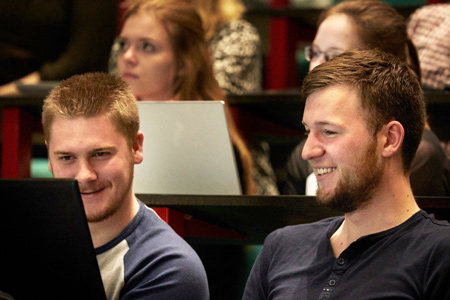The latest brain scanning methods and eye tracking can be used to customize teaching for individual students, thus making it much more effective.
In an ideal world, all students would have their own personal teacher, who could design the teaching to accommodate their personal level and optimal learning patterns. Unfortunately, that is seldom the case in reality, but you can actually come quite close to it using big data and technological aids. Researchers at DTU are well on their way to developing the teaching tools of the future.
If you take a look at an auditorium packed with young people, they may look like a relatively uniform bunch. But if you focus on each and every one of them, you will soon discover a host of individual expressions. Furthermore, if you look behind the haircut and deep into the brain, you will spot even more differences. These are the differences that ordinary teaching cannot take into account, but if it could, it would become much more efficient and produce even better-qualified graduates.
If you mention ‘brain scanning’, people generally tend to envisage large, expensive machines in which the subject has to lie motionless while the scan is performed. However, it is actually possible to capture the brain’s electrical impulses using sensors positioned in a cap. It is a cap of precisely this kind that researchers at DTU Compute have developed, and their invention has been used in experiments to measure brain activities in several test subjects while they were watching different films.
In a new project, researchers will now attempt to move even closer to the individual student. They have teamed up with a former student—now a professor at Aarhus University—who has developed a tiny scanner that can be placed in the test subject’s ear and send measurements to a computer. Professor Lars Kai Hansen, Head of Section, relates:
“A scanner like this enables us systematically to collect data about the students’ activity and then offer them more individual teaching. Naturally, this requires them to be willing to pass on their personal data, but there is plenty of evidence to suggest most of them have no problem doing so. After all, the better you know yourself, the better you can optimize your functions and make the very most of your studies.”
“Of course, it is essential to ensure you have taken care of the ethical dimension, and that you prevent the private data from becoming common knowledge,” adds Professor Rasmus Larsen, Head of Department. “You can actually compare it to a medical trial or a confidential consultation between doctor and patient. The ultimate aim of bespoke teaching is obviously beneficial, so we just have to make sure to tackle the technical issues surrounding security.”
Eyes don’t lie
While brain scanning is a new tool because the technology involved is still in its infancy, eye tracking is a technology that is already commonly used—in flight simulators, for example.
“The eyes reveal what you’re interested in and give some indication of your current state; pupil size and frequency of blinking are related to your emotional status,” explains Rasmus Larsen, who adds that the technology is well within reach. Some of the latest equipment can actually be incorporated into smartphones—which already have a camera to let people take selfies—where it will be able to register eye movements. Moreover, he is convinced that eye tracking systems will soon become absolutely standard equipment in computers.
"The eyes reveal what you’re interested in and give some indication of your current state; pupil size and frequency of blinking are related to your emotional status."
Rasmus Larsen, Head of Department, DTU Compute

Rasmus Larsen, Head of Department at DTU Compute, has no doubt that digitization is on its way to turning the field of education upside down.
“We’ve already come a long way with digitized content. Textbooks are e-books, and you can video lectures and then watch them again later. The next step is to have computers correct student assignments, both the simple multiple choice exercises and the more complex ones. And then we need to move on to a set-up where the lecturer uses the data collected to react to the input of the individual student. If students answer correctly, they can move on to the next topic; if not, they will need to complete a few more exercises. These systems already exist—we use them in the introductory maths teaching here at DTU—and they constitute a powerful, highly motivational learning tool.”
Personalized teaching
Much more information can be fed into the loop, however. The student may be sat working on a specific assignment and the lecturer can see that he or she has the textbook open to the wrong page. If the student has not made any progress for a while, the lecturer can ask him or her to look at a different page, or to watch a specific video clip from a previous lecture.
“This is what we mean by personalized teaching—or targeted assistance—to help students help themselves. While the physical contact between lecturer and student is, of course, indispensable, technology can help the lecturer provide input in precisely the right places in relation to the individual student. In this way, we can significantly improve quality using the same resources,” concludes Rasmus Larsen.